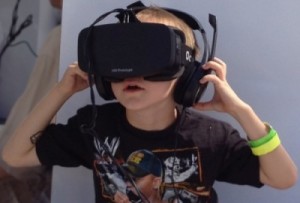For years we’ve heard about the potential of virtual reality, but even when the virtual world Second Life was a hot tech-news story, it hardly felt like a second life to most people. I wrote about it a number of times because of the amazing work some very cutting-edge educators and their students were doing in Teen Second Life, when it existed. Then it faded into the background, and those teachers moved on to Minecraft, which is even less immersive than Second Life but compelling because such a vast empty slate for players’ (and educators’) creativity.
 The news of Facebook’s plan to acquire startup Oculus VR for $2 billion put virtual worlds back on tech-news center stage (teacher Marianne Malmstrom, whose work with students in Minecraft I’ve covered, is now testing it with her students). Oculus is even more immersive than a Second Life or a Minecraft. Instead of watching your avatar move around on a screen, you don’t even see a screen; you’re in the scene itself – with the help of a very fancy headset for eyes and ears. Here’s how Oculus Rift’s developer Palmer Luckey explains it.
The news of Facebook’s plan to acquire startup Oculus VR for $2 billion put virtual worlds back on tech-news center stage (teacher Marianne Malmstrom, whose work with students in Minecraft I’ve covered, is now testing it with her students). Oculus is even more immersive than a Second Life or a Minecraft. Instead of watching your avatar move around on a screen, you don’t even see a screen; you’re in the scene itself – with the help of a very fancy headset for eyes and ears. Here’s how Oculus Rift’s developer Palmer Luckey explains it.
Humanizing, not dehumanizing
Online community manager Jesse Coombe at eModeration explains how immersive is good for business as well as education (not just the social media business) – and is probably the next platform, after mobile, for all interaction, including our kids’: “In a world where virtual reality is a key part of Facebook’s feature set, these conversations will have more in common with the interactions you experience when customers physically enter your place of business. You will design your virtual 3D space to best represent your company, just as you do now with a Facebook cover photo or the presentation of your brick and mortar stores and offices. Your VR goggle-wearing customer response team will have a physical presence in the space, made to your design and controlled by your staff’s own movements and commands.”
Part of what made having an avatar in Second Life so compelling, even a teeny bit magical – I discovered when working, shopping, hanging out and giving talks as Anny Khandr in Second Life – was not only that I could create my own in-world personae, make Anny anything I wanted her to be, but that I could interact with colleagues doing the same. And there was something a little magical – playful – about meeting these colleagues (mostly educators) for the first time in the offline world, such as at the ISTE conference. There was something a little extra humanizing about interacting with others in both digital and physical environments.
May add empathy back in
Facebook has been working with researchers at University of California, Berkeley, Yale University and Stanford University to understand better how to foster empathy in social media, but empathy may arise fairly naturally on a virtual reality platform, as it did for many of us in Second Life. As Jesse at eModeration writes, “Think of the difference between the feeling you get from an email conversation, and the feeling of sitting down with someone to meet in person. Isn’t it so much easier to gauge the way someone feels when you can see them in front of you? Virtual reality has the potential to replicate this for conversations that occur on opposite sides of the world.”
Reams have been written about various kinds of digital immersion, but not so much about the blend of virtual reality’s immersiveness, online/offline interaction and the potential for increased empathy – and creativity as a result. This is something we’ll want to watch and, if Facebook helps virtual reality go mainstream (as Oculus VR’s developers reportedly believe it will) and your kids get immersed, take the advice of media professor and parent Stephen Heppell and talk with them about what they’re experiencing!
Related links
- “Facebook in $2 Billion Deal for Virtual Reality Company” at the New York Times
- A skeptical commentary on this development at CNET
- One step closer to the metaverse? (Or Ready Player One? If you haven’t read that novel, you might enjoy it; I did.) See a commentary about Facebook, its “real name culture” and the metaverse at TechCrunch
- A 2009 post “My avatar, myself” and a 2008 one about research at Stanford on the benefits of having virtual selves
Disclosure: I’m co-director of ConnectSafely.org, a nonprofit organization that receives financial support from a number of Internet and media companies, including Facebook, Google, Trend Micro and Yahoo.

Leave a Reply